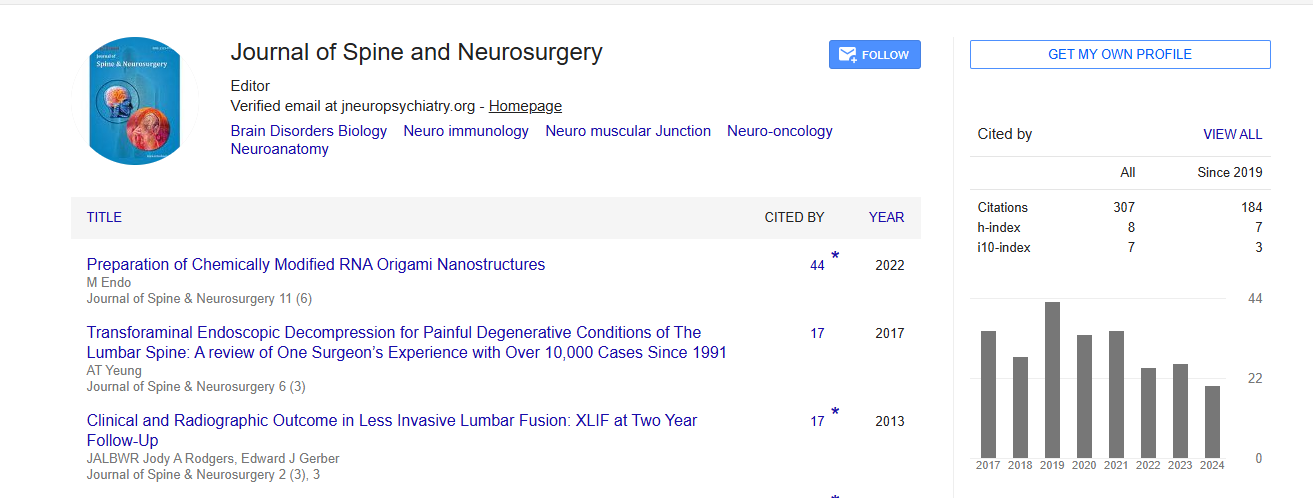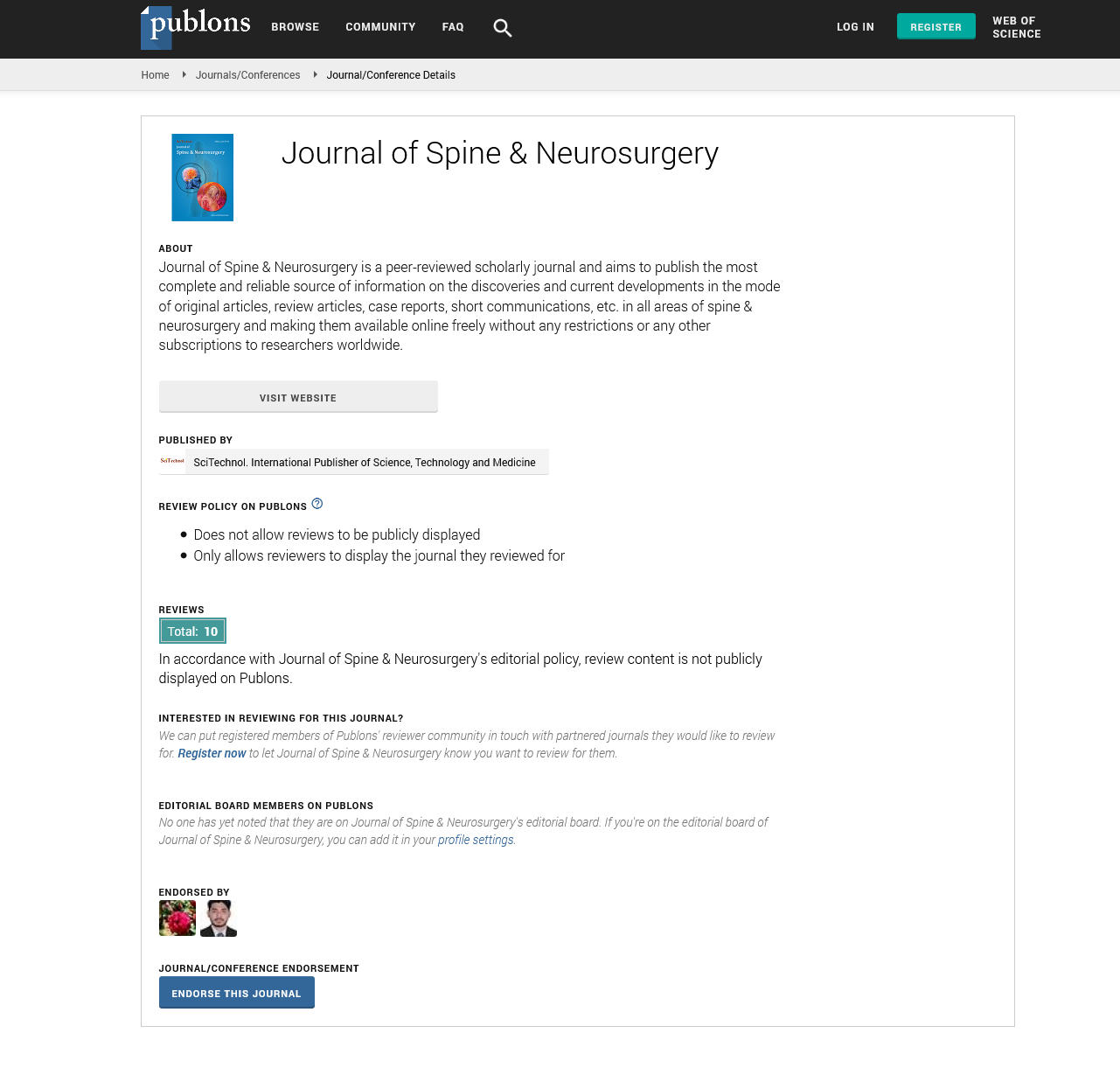Opinion Article, J Spine Neurosurg Vol: 12 Issue: 6
Understanding Prosopagnosia: Exploring Face Identity Issues in Both Congenital and Acquired Cases
Xinhia Jin*
1Department of Physiology, University of Toronto, Toronto, Canada
*Corresponding Author: Xinhia Jin,
Department of Physiology, University of
Toronto, Toronto, Canada
E-mail: xinhia_01jin@gmail.com
Received date: 27 November, 2023, Manuscript No. JSNS-24-128397;
Editor assigned date: 29 November, 2023, PreQC No. JSNS-24-128397 (PQ);
Reviewed date: 14 December, 2023, QC No. JSNS-24-128397;
Revised date: 21 December, 2023, Manuscript No. JSNS-24-128397 (R);
Published date: 28 December, 2023, DOI: 10.4172/2325-9701.1000188.
Citation: Jin X (2023) Understanding Prosopagnosia: Exploring Face Identity Issues in Both Congenital and Acquired Cases. J Spine Neurosurg 12:6.
Description
Prosopagnosia, commonly known as face blindness, is a neurological condition that challenges the fundamental human ability to recognize faces. In a society where facial recognition is a cornerstone of social interaction, understanding the complexities and impacts of prosopagnosia becomes vital. This delves into the complex aspects of this condition, exploring its causes, symptoms, and the profound effects it has on the daily lives of those affected. Prosopagnosia can be broadly categorized into two types: developmental (congenital) and acquired.
The congenital form is present from birth and may have a genetic basis, while acquired prosopagnosia results from brain damage, often due to injury, stroke, or specific neurological conditions. The common denominator is dysfunction in the Fusiform Face Area (FFA) and the Occipital Face Area (OFA), two regions of the brain central for facial processing. In developmental prosopagnosia, individuals may not even be aware of their condition until later in life when they notice consistent difficulties recognizing faces. On the other hand, acquired prosopagnosia often follows a traumatic event, like head injury or stroke, and the inability to recognize faces become evident after the incident.
Symptoms
The hallmark symptom of prosopagnosia is the inability to recognize faces, extending beyond strangers to encompass even close friends and family. This challenge is not limited to unfamiliar faces; individuals with prosopagnosia often struggle with recognizing even those they should theoretically know well. The condition can manifest in varying degrees of severity. Some individuals may experience a milder form, where they can recognize familiar faces but struggle with new acquaintances. In contrast, others may have a more profound impairment, being unable to recognize even the most familiar faces in their lives. The variability in symptom severity makes each case unique and requires tailored coping strategies.
Psychosocial impact
Living with prosopagnosia goes beyond the mere inconvenience of occasionally failing to recognize someone in a crowd. It can have profound psychosocial implications. The struggle to discern faces can lead to social anxiety, embarrassment, and feelings of isolation. Individuals with prosopagnosia often develop coping mechanisms, such as relying on contextual clues, distinctive features, or even voice recognition to identify others. The condition can also impact interpersonal relationships. Imagine not being able to distinguish between family members or close friends in a social setting, relying on contextual cues to determine the people you interact with. This constant effort to compensate for the inability to recognize faces can be mentally exhausting, affecting one's overall well-being.
Diagnosis and coping strategies
Diagnosing prosopagnosia involves a comprehensive assessment by healthcare professionals, typically neurologists or neuropsychologists. Standard diagnostic tools may include face recognition tests and cognitive assessments to evaluate the extent of impairment. While there is no cure for prosopagnosia, individuals can employ various strategies to cope with the challenges it presents. Many rely on alternative recognition methods, such as memorizing distinctive features, paying attention to hairstyles or clothing, and using voice recognition. Additionally, some engage in face recognition exercises and may benefit from support groups or counseling to manage the emotional toll of living with face blindness.
Conclusion
Advancements in neuroscience continue to deepen our understanding of prosopagnosia and offer hope for improved interventions. Neuroimaging techniques, such as Functional Magnetic Resonance Imaging (fMRI) and Positron Emission Tomography (PET), provide valuable insights into the neural processes involved in facial recognition. Cognitive rehabilitation therapies, designed to enhance face recognition skills, are also being explored to improve the quality of life for those with prosopagnosia. Prosopagnosia, though relatively uncommon, unveils the intricacies of human facial recognition and the profound impact it has on daily life. By understanding the causes, symptoms, and psychosocial implications of face blindness, we can foster empathy and support for those navigating a world without faces. As research progresses, there is hope for improved diagnostic tools and interventions, offering a brighter future for individuals living with this unique and challenging condition.
 Spanish
Spanish  Chinese
Chinese  Russian
Russian  German
German  French
French  Japanese
Japanese  Portuguese
Portuguese  Hindi
Hindi 
